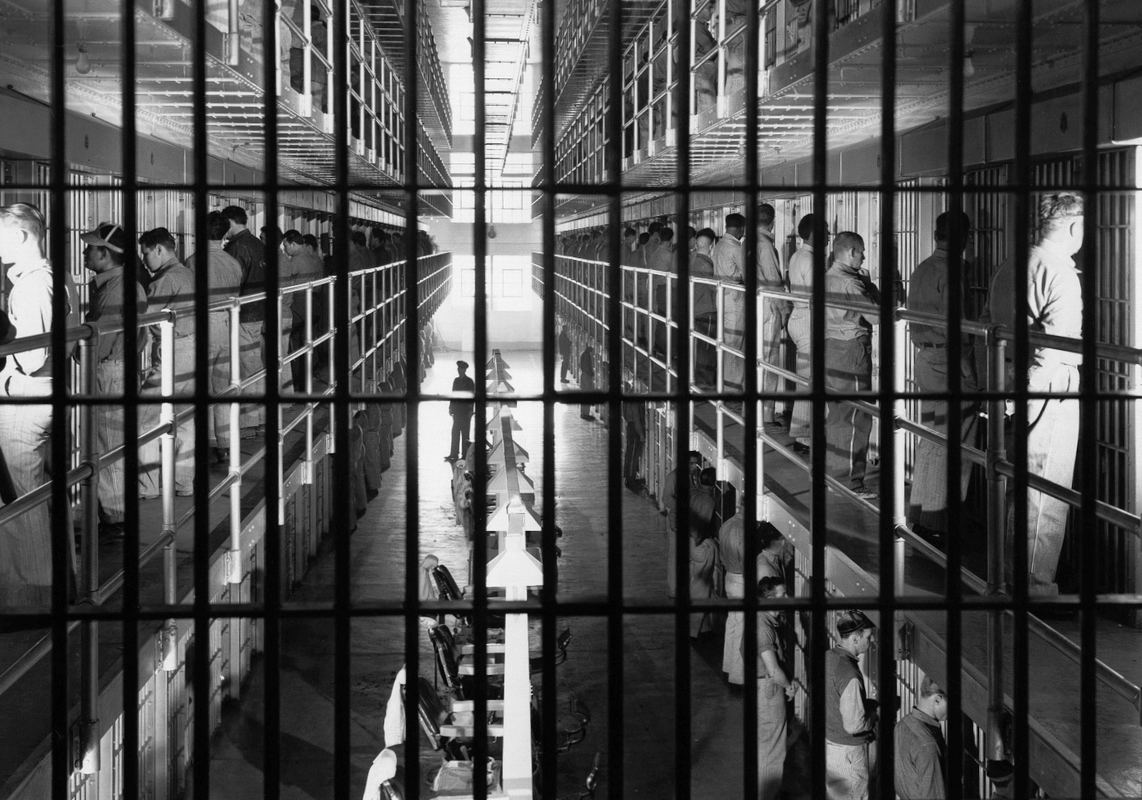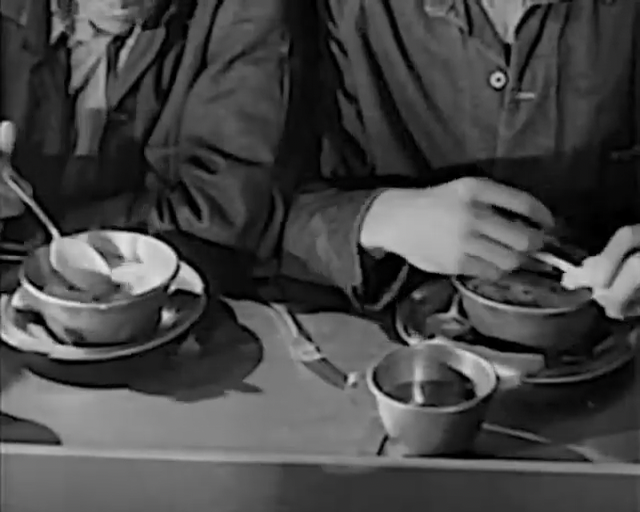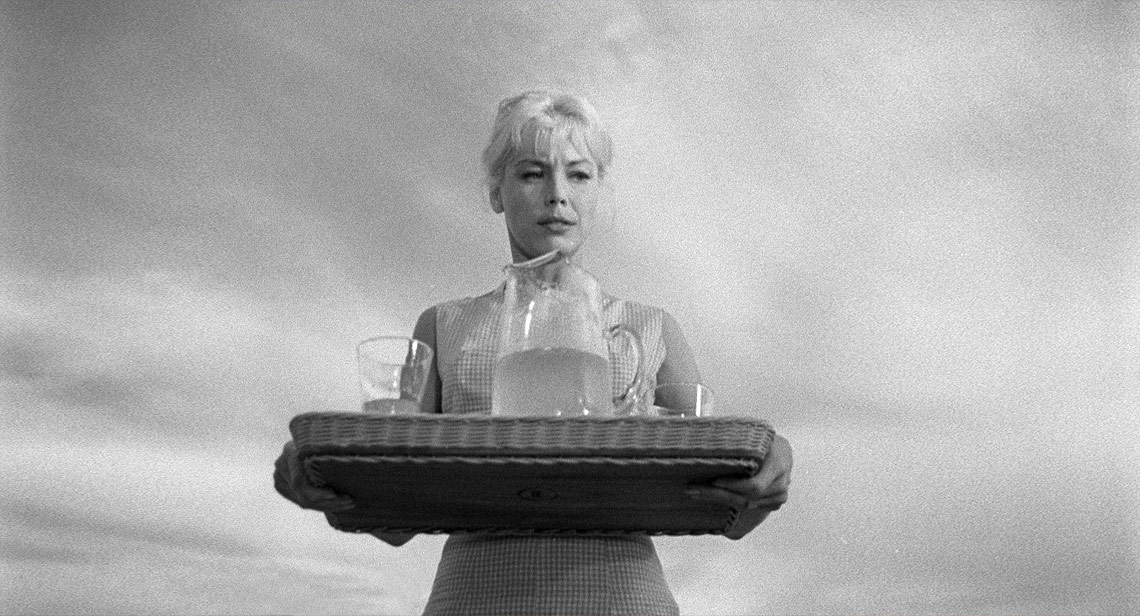“Nice guys.” Canon City (Crane Wilbur, 1948)
Aug
1
Colorado Day

Counting the inmates. DP: John Alton.
They've been planning this for months, Canon City's Colorado Territorial Correctional Facility's toughest inmates. It's going to happen on December 30, and all men are ready to go.
Fascinating about Canon City is the usage of some of the actual locations, ánd people, involved in the 1947 #prison break.
Also striking, unfortunately, is the unevenness of the affair. John Alton's cinematography, while wonderful, wanders between noir and stuck camera shutter. And that voice-over… well, lets not mention that at all.
thriller
Canon City (Crane Wilbur, 1948)
Jul
31
grub

A close-up of two prisoners' hands. One is handling grub with a spoon from a stainless steel soup bowl. DP: John Alton.
– He's got a calendar in there.
– What day is it?
– It's a broad in a cowboy hat.
– Scooby doo bi doo ba ba.Private Property (Leslie Stevens, 1959/1960)
Jul
21

Duke (Corey Allen) and Boots (Warren Oates) “watching TV”. Ann Carlyle (Kate Manx) stripping for her husband is on. DP: Ted D. McCord.
Date watched, not the date in the movie. The quote was too good to leave it off this blog.
“You know how much coffee I've had today? 17 cups. The Brazilians ought to give me a medal.”The Sniper (Edward Dmytryk, 1952)
Jul
21
chow mein

Dr. James G. Kent (Richard Kiley) discussing the case during lunch at a Chinese restaurant. After scratching his temple with his chopsticks, he attempts to eat his noodles with the utensils' grip. DP: Burnett Guffey.
– ER doctor
“I'm looking for the Hitchcock residence.”Private Property (Leslie Stevens, 1960)
Jul
20
lemonade

A blonde lady (Kate Manx) holds a wicker ray with a pitcher of lemonade and several glasses. Her anxious look contrast with the carefree promise of summer sky and cool drinks. DP: Ted D. McCord.
– Duke
“Stop to eat every 8 hours. Just sandwiches.”Plunder Road [The Violent Road] (Hubert Cornfield, 1957)
Jul
10
sandwiches

At a diner, a dark-haired waitress holds up a carafe with fresh coffee and a take-away cup. A man in the background appears to keep an eye on her. DP: Ernest Haller.
“It isn't Jesus. It's just a fella.”Whistle Down the Wind (Bryan Forbes, 1961)
Jul
9
white bread

A child grabs a thick slice of white bread while the cutlery on her plate indicates she's finished eating. DP: Arthur Ibbetson.
– Charlie Bostock
“Good night, Gentle Jesus. Sleep well.”Whistle Down the Wind (Bryan Forbes, 1961)
Jul
9
Barn Day

The man (Alan Bates) in the barn surrounded by little children. The older girl in the light coat, Kathy, is played by Hayley Mills, author Mary Hayley Bell's daughter. DP: Arthur Ibbetson.
In the barn of a remote Lancashire farmhouse, three children stumble upon a stranger. Confused, they conclude that the fellow must be the Second Coming of Christ. In the world of the adults, a man is wanted by the police.
– Charlie Bostock
“Things last as long as they last.”Peppermint Frappé (Carlos Saura, 1967)
Jun
30
Drive Your Corvette To Work Day

Producer Elías Querejeta (far left) and others pushing Geraldine Chaplin character Elena's Chevrolet Corvette C1. Behind the wheel actor José Luis López Vázquez (Julián). DP: Luis Cuadrado.
A chance encounter with a blonde drummer during the Holy Week in the village of Calanda leaves a deep impression on Julián (José Luis López Vázquez). When years later he reunites with his childhood friend Pablo, he finds that Pablo is married to bubbly cosmopolitan Elena (Geraldine Chaplin), the spitting image of the elusive drummer. Infatuated he tries to court her, but Elena sees nothing in the drab radiologist. Julián then turns his attention to his shy assistant Ana (also Chaplin) and grooms her into becoming the two unattainable women.
– Pablo
Saura's Peppermint Frappé takes #Hitchcock's Vertigo (1958) – indeed the peppermint green of the drink is an homage – with a twist of #Buñuel and serves it over an anti-#Francoist tale of self-doubting machismo obsessing over The Other. Even Elena's car, American instead of a much more obvious European model, dismisses fascist Spain's perceived superiority. Indeed the Generalisimo drove a Cadillac.
– Aw, mom. You always talk about civilization. – Don't knock it, son. Jeopardy (John Sturges, 1953)
Jun
25
National Camp Counts Day

Behind the scenes. Barbara Stanwyck as unhappy camper Helen Stilwin having her lipstick reapplied by makeup man Pat McNalley. DP: Victor Milner.
A nuclear family of three goes out on a #camping-slash-fishing-trip on a remote Mexican beach. On arrival, son Bobby (Lee Aaker) causes trouble by climbing a rickety old jetty, which then collapses after dad Doug (Barry Sullivan) frees the boy's stuck foot. Now with Doug stuck and the tide rolling in, Helen (Barbara Stanwyck) is on her own and needs to find a rope. And help…
John Sturges' Jeopardy is a thrilling reverse home invasion based on Maurice Zimm's radioplay A Question of Time. Without falling into the trap of an illustrated radio broadcast, the haunting photography by Victor Milner, small, intense cast, short runtime and claustrophobic sets make for a very modern, economic thriller.
And Barbara Stanwyck the type of heroine we wouldn't see much of until decades later.